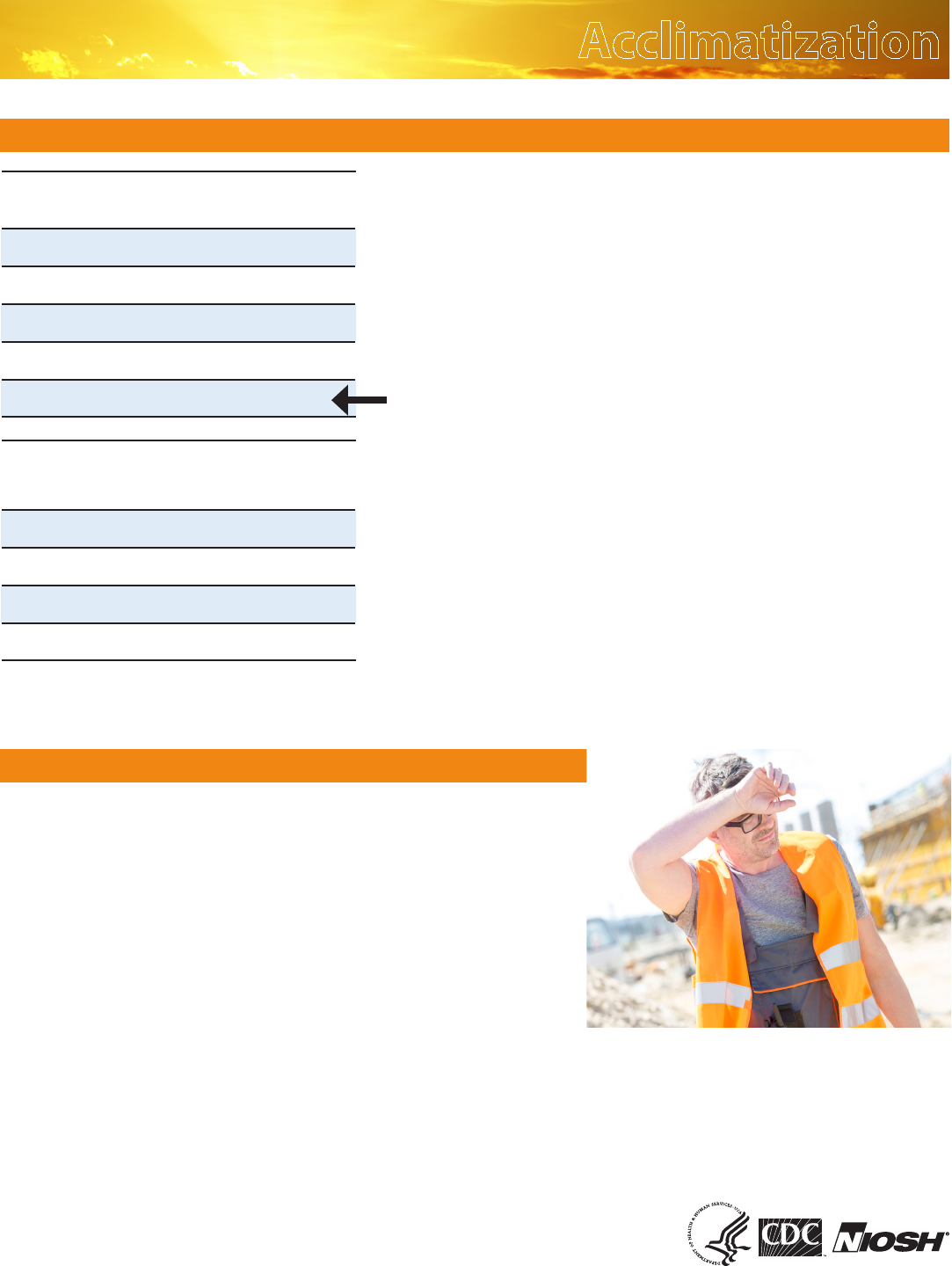
heat stress
Acclimatization
New employees are at the highest risk for heat illness.
Acclimatization is crucial to working in hot conditions.
Things you need to know:
•
Heat acclimatization is the improvement in
heat tolerance that comes from gradually
increasing the intensity or duration of work
performed in a hot setting.
•
The best way to acclimatize yourself to the
heat is to increase the workload performed
in a hot setting gradually over a period of
1–2 weeks.
•
You begin to lose your acclimatization
after about 1 week away from working in
the heat.
Photo by NIOSH
What are the benefits of heat acclimatization?
• Heat exposure causes less strain to the heart and other vital organs.
• Sweating improves (higher volume, earlier onset), which cools the
body more quickly. Acclimatized workers need more water—not less—
due to increased sweating.
• Workers increase their ability to comfortably perform physical tasks
in the heat.
Tips for acclimatization
• Best results will come from gradually increasing work time in hot conditions over a period of 7 to 14 days,
and cooling off and fully rehydrating between shifts.
• Pushing to the point of heat exhaustion will hurt, not help, your heat tolerance.
• Typically, acclimatization requires at least two hours of heat exposure per day (which can be broken into
two, 1-hour periods).
• The body will acclimatize to the level of work demanded of it. Simply being in a hot place is not sufficient.
Doing light or brief physical work in the heat will acclimatize you ONLY to light, brief work. More
strenuous or longer tasks require more acclimatization.
• Stay hydrated! Dehydration reduces the benefits of heat acclimatization.
• Eating regular meals aids acclimatization. Food replaces electrolytes lost in sweat, especially during the
first few days of acclimatization, when you lose the most salt in sweat.
• Physical fitness aids acclimatization.
How quickly does the body LOSE heat tolerance after acclimatization?
• Acclimatization will be maintained for a few days after heat exposure stops, but will begin to be lost after
about 1 week away from working in the heat.
• After 1 month away from work in the heat, most people’s heat tolerance will have returned to baseline.
• Working for 1–2 days in cooler conditions or taking breaks in air conditioning will not hurt
acclimatization.

heat stress Acclimatization
Sample Acclimatization Schedule
NIOSH Acclimatization Recommendations
for New Workers
1st day 20% usual work duration
2nd day 40% usual work duration
3rd day 60% usual work duration
4th day 80% usual work duration
5th day 100% usual work duration
NIOSH Acclimatization Recommendations
for Workers with Previous Experience
*
with
the Same Job
1st day 50% usual work duration
2nd day 60% usual work duration
3rd day 80% usual work duration
4th day 100% usual work duration
*Workers returning from an absence
• Managers should have a formal acclimatization plan for
employees working in the heat. Starting new employees at
full intensity is not safe.
• Adjustments to the acclimatization schedule may be
needed depending on the worksite’s situation and on
individual factors.
• Most workers should be able to safely handle a full
workload after 4 days of gradual increase, even though
they will usually not be fully acclimatized yet. Most
people will continue to see benecial improvements in
heat tolerance for up to 2 weeks after exposure starts.
• Sudden shifts in work intensity or sudden increases in
environmental temperature can increase the risk for heat
illness even for acclimatized workers.
Case Study: Hazards of Not Acclimatizing Workers
A 41-year-old construction worker was sawing boards in 93 °F
heat. At 5 p.m., the worker collapsed in the parking lot. He was
found by another employee. His body temperature was recorded
at 108 °F when he was admitted to the hospital. He died the next
day. At the time of the incident, the employee had been working
for the company for one day. The company had no formal heat
stress policy or acclimatization plan.
Lessons Learned
• Heat casualties often occur with new or less experienced
employees.
• Deaths from heat stress often occur during the rst few days
on the job.
• Employers should have heat stress policies, and should implement acclimatization plans.
Photo by ©Thinkstock
DEPARTMENT OF HEALTH AND HUMAN SERVICES
Centers for Disease Control and Prevention
National Institute for Occupational Safety and Health
DHHS (NIOSH) Publication No. 2017-124
